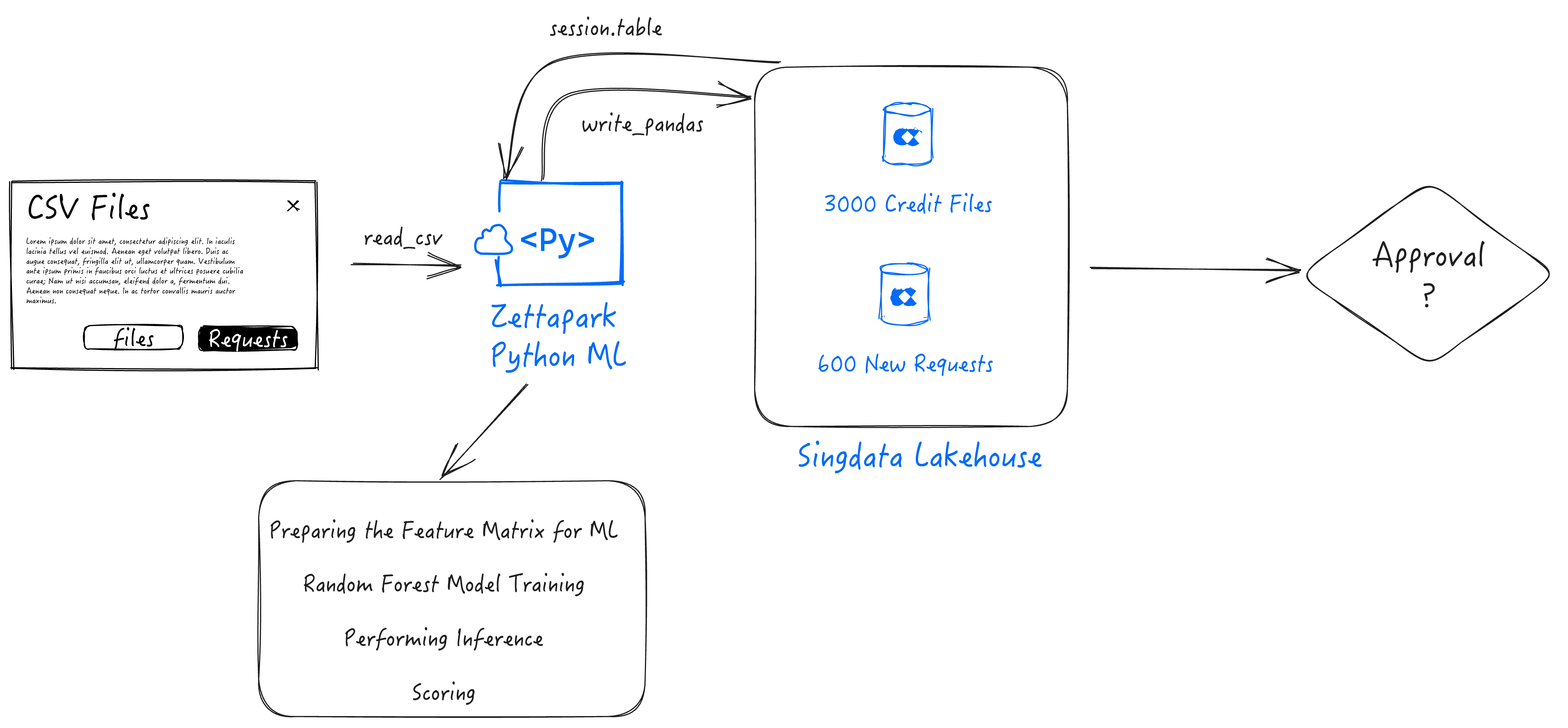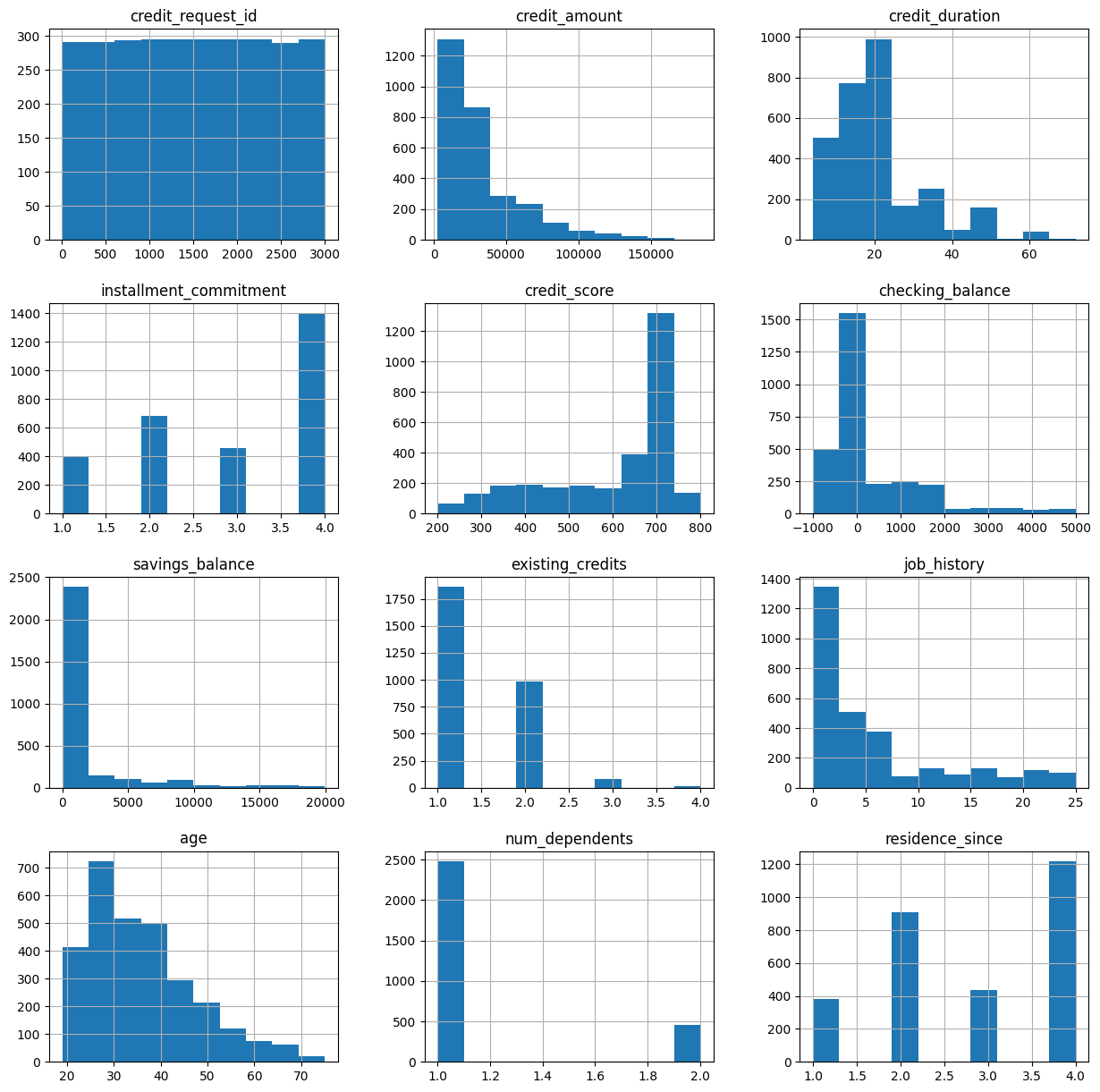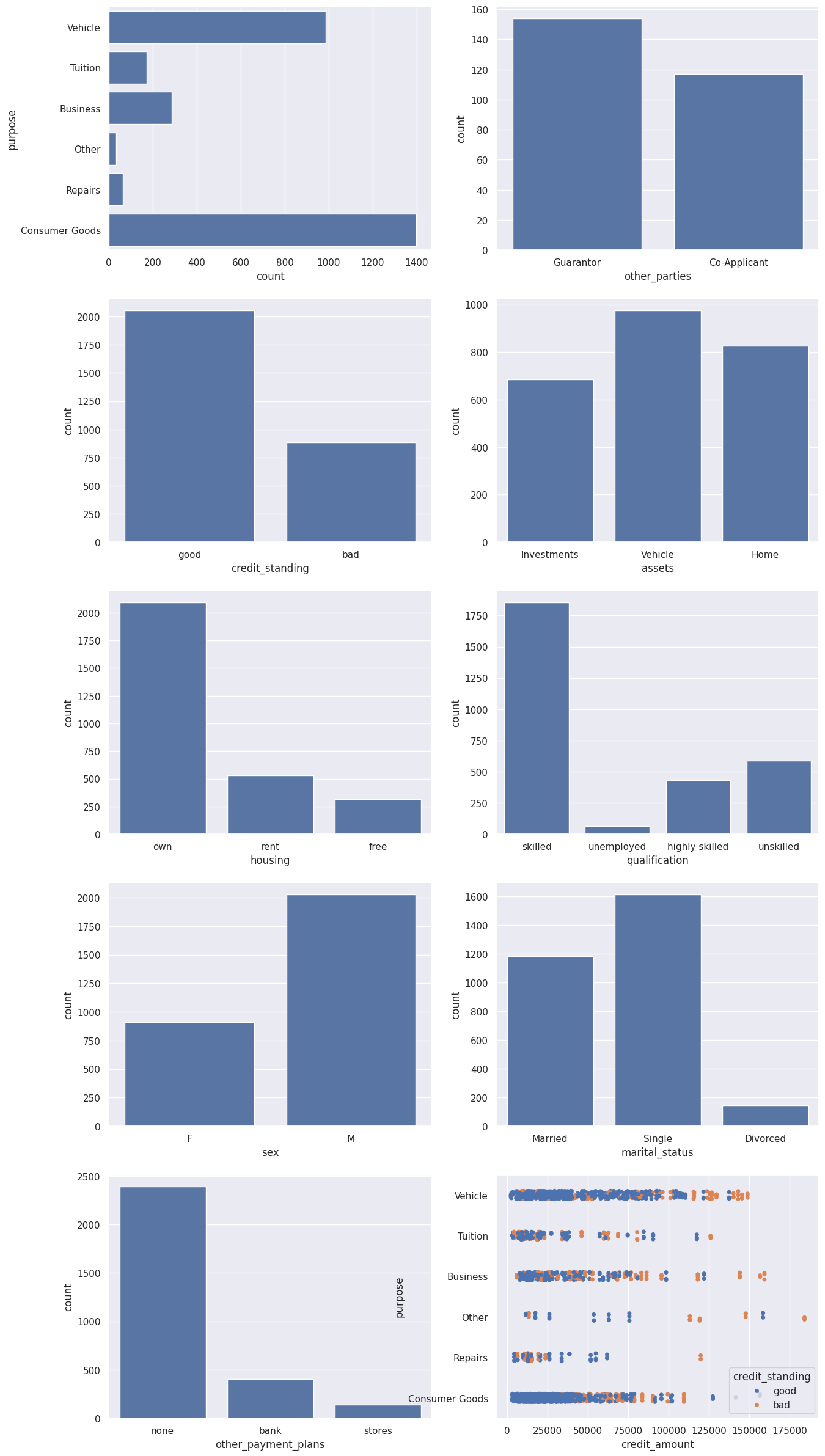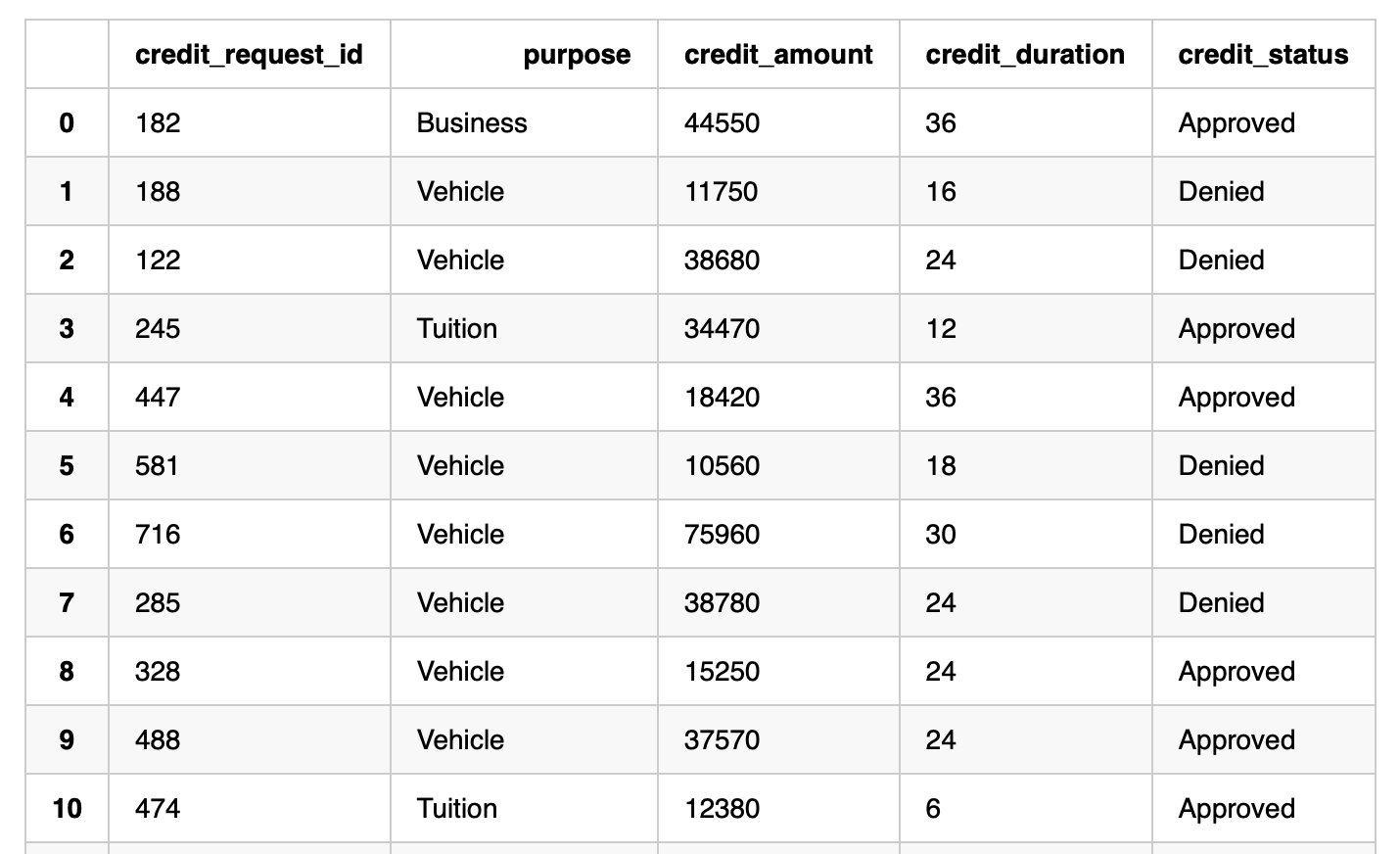Credit Scoring with Zettapark and Python ML library
Overview
In this step by step tutorial, you will be able to use Zettapark for Python, along with your favorite python libraries for data analysis and visualization, as well as the popular scikit learn ML library to address an end to end machine learning use case.

Prerequisite
- Singdata Lakehouse Account
- Client side Zettapark environment with Zettapark library installed.
What you'll learn
- Get an understanding on how to implement an end-to-end ML pipeline using Zettapark for Python.
- Develop using Zettapark for Python API, vectorized Functions.
- Data Exploration, visualization and preparation using Python popular libraries (Pandas, seaborn).
- Machine Learning using scikit-learn python package
- Deploying and using an ML model for scoring using Zettapark for Python.
Usage/Steps
- Step 1: Run through the Credit Scoring Setup Notebook. This will download the dataset, and create the database and tables needed for this demo. Make sure to customize config.json
- Step 2: You can now run the Credit Scoring tutorial.
You could Get the Source Code(Jupyter Notebook ipynb file) and data file From Github Repository.
Credit Scoring with Zettapark for Python Set-up Notebook
1. Singdata Lakehouse Trial Account
The prerequisite is to have a Singdata Lakehouse account. If you do not have a Singdata Lakehouse account, you can cantact us for a free trial using.
After signing-up for the trial, please bookmark the URL of the Singdata Lakehouse account, and save your credentials as they will be needed in this lab.
This version requires Zettapark 0.1.2 or higher
2. Python Libraries
The following libraries are needed to run this demo. In this section, add any python library missing in your environment.
# !pip install -q --upgrade clickzetta_zettapark_python
# !pip install scikit-plot
# !pip install pyarrow==6.0.0
# !pip install matplotlib
3. File Download
3.1 The Dataset
! curl -o data/credit_files.csv https://raw.githubusercontent.com/yunqiqiliang/clickzetta_quickstart/refs/heads/main/Zettapark-credit-scoring/data/credit_files.csv
% Total % Received % Xferd Average Speed Time Time Time Current
Dload Upload Total Spent Left Speed
100 292k 100 292k 0 0 66280 0 0:00:04 0:00:04 --:--:-- 69100
! curl -o data/credit_request.csv https://raw.githubusercontent.com/yunqiqiliang/clickzetta_quickstart/refs/heads/main/Zettapark-credit-scoring/data/credit_request.csv
% Total % Received % Xferd Average Speed Time Time Time Current
Dload Upload Total Spent Left Speed
100 6068 100 6068 0 0 2297 0 0:00:02 0:00:02 --:--:-- 2297
3.2 The config.json credential file
The file below needs to be edited with credentials of your Singdata Lakehouse account and saved. It will be used to connect to Singdata Lakehouse on the main Notebook:
{
"username": "<username>",
"password": "<password>",
"service": "<service url>",
"instance": "<instance id>",
"workspace": "<workspace>",
"schema": "<schema>",
"vcluster": "<vcluster>",
"sdk_job_timeout": 60,
"hints": {
"sdk.job.timeout": 60,
"query_tag": "test_zettapark_credit_scoring"
}
}
! curl -o config/config_tobe_renamed.json https://raw.githubusercontent.com/yunqiqiliang/clickzetta_quickstart/refs/heads/main/Zettapark-credit-scoring/config/config.json
% Total % Received % Xferd Average Speed Time Time Time Current
Dload Upload Total Spent Left Speed
100 321 100 321 0 0 138 0 0:00:02 0:00:02 --:--:-- 138
4. The Database
In the section below, please fill-up the different parameters to connect to your Singdata Lakehouse Environment in the config.json file.
import pandas as pd
import json
from clickzetta.zettapark.session import Session
import clickzetta.zettapark.functions as F
import warnings
warnings.filterwarnings("ignore", category=FutureWarning)
# read connection para from config file
with open('config/config.json', 'r') as config_file:
config = json.load(config_file)
schema = config['schema']
vcluster = config['vcluster']
print("Connecting to Lakehouse.....\n")
# create session
session = Session.builder.configs(config).create()
session.sql(f"CREATE SCHEMA IF NOT EXISTS {schema}").collect()
session.sql(f"CREATE VCLUSTER IF NOT EXISTS {vcluster} VCLUSTER_SIZE=1 VCLUSTER_TYPE = GENERAL").collect()
print(session.sql("SELECT current_instance_id(), current_workspace(),current_workspace_id(), current_schema(), current_user(),current_user_id(), current_vcluster()").collect())
print("\nConnected!...\n")
5. The Tables
There are 2 tables associated with this demo:
-
CREDIT_FILES: This table contains currently the credit on files along with the credit standing whether the loan is being repaid or if there are actual issues with reimbursing the credit. This dataset is going to be used for historical analysis and build a machine learning model to score new applications.
-
CREDIT_REQUESTS: This table contains the new credit requests that the bank needs to provide approval on based on the ML algorithm.
5.1 CREDIT_FILES Table
After check running the command below, log into your Singdata Lakehouse environment and make sure the table was created. It should have 2.9K rows.
credit_files = pd.read_csv('data/credit_files.csv')
credit_files.columns = credit_files.columns.str.lower()
session.sql("drop table if exists CREDIT_FILES").collect()
session.write_pandas(credit_files,"CREDIT_FILES",auto_create_table='True', quote_identifiers=False)
<clickzetta.zettapark.table.Table at 0x7fe58538e990>
credit_df = session.table("CREDIT_FILES")
credit_df.schema
StructType([StructField('`credit_request_id`', LongType(), nullable=True), StructField('`credit_amount`', LongType(), nullable=True), StructField('`credit_duration`', LongType(), nullable=True), StructField('`purpose`', StringType(), nullable=True), StructField('`installment_commitment`', LongType(), nullable=True), StructField('`other_parties`', StringType(), nullable=True), StructField('`credit_standing`', StringType(), nullable=True), StructField('`credit_score`', LongType(), nullable=True), StructField('`checking_balance`', DoubleType(), nullable=True), StructField('`savings_balance`', DoubleType(), nullable=True), StructField('`existing_credits`', LongType(), nullable=True), StructField('`assets`', StringType(), nullable=True), StructField('`housing`', StringType(), nullable=True), StructField('`qualification`', StringType(), nullable=True), StructField('`job_history`', LongType(), nullable=True), StructField('`age`', LongType(), nullable=True), StructField('`sex`', StringType(), nullable=True), StructField('`marital_status`', StringType(), nullable=True), StructField('`num_dependents`', LongType(), nullable=True), StructField('`residence_since`', LongType(), nullable=True), StructField('`other_payment_plans`', StringType(), nullable=True)])
credit_df.toPandas().head()
credit_df.toPandas().info()
<class 'pandas.core.frame.DataFrame'>
RangeIndex: 2940 entries, 0 to 2939
Data columns (total 21 columns):
# Column Non-Null Count Dtype
--- ------ -------------- -----
0 credit_request_id 2940 non-null int64
1 credit_amount 2940 non-null int64
2 credit_duration 2940 non-null int64
3 purpose 2940 non-null object
4 installment_commitment 2940 non-null int64
5 other_parties 271 non-null object
6 credit_standing 2940 non-null object
7 credit_score 2940 non-null int64
8 checking_balance 2940 non-null float64
9 savings_balance 2940 non-null float64
10 existing_credits 2940 non-null int64
11 assets 2489 non-null object
12 housing 2940 non-null object
13 qualification 2940 non-null object
14 job_history 2940 non-null int64
15 age 2940 non-null int64
16 sex 2940 non-null object
17 marital_status 2940 non-null object
18 num_dependents 2940 non-null int64
19 residence_since 2940 non-null int64
20 other_payment_plans 2940 non-null object
dtypes: float64(2), int64(10), object(9)
memory usage: 482.5+ KB
5.2 CREDIT_REQUEST Table
After check running the command below, log into your Singdata Lakehouse environment and make sure the table was created. It should have 60 rows.
credit_requests = pd.read_csv('data/credit_request.csv')
credit_requests.columns = credit_requests.columns.str.lower()
session.sql("drop table if exists CREDIT_REQUESTS").collect()
session.write_pandas(credit_requests,"CREDIT_REQUESTS",auto_create_table='True', quote_identifiers=False)
credit_req_df = session.table("CREDIT_REQUESTS")
credit_req_df.schema
StructType([StructField('`credit_request_id`', LongType(), nullable=True), StructField('`credit_amount`', LongType(), nullable=True), StructField('`credit_duration`', LongType(), nullable=True), StructField('`purpose`', StringType(), nullable=True), StructField('`installment_commitment`', LongType(), nullable=True), StructField('`other_parties`', StringType(), nullable=True), StructField('`credit_score`', LongType(), nullable=True), StructField('`checking_balance`', DoubleType(), nullable=True), StructField('`savings_balance`', DoubleType(), nullable=True), StructField('`existing_credits`', LongType(), nullable=True), StructField('`assets`', StringType(), nullable=True), StructField('`housing`', StringType(), nullable=True), StructField('`qualification`', StringType(), nullable=True), StructField('`job_history`', LongType(), nullable=True), StructField('`age`', LongType(), nullable=True), StructField('`sex`', StringType(), nullable=True), StructField('`marital_status`', StringType(), nullable=True), StructField('`num_dependents`', LongType(), nullable=True), StructField('`residence_since`', LongType(), nullable=True), StructField('`other_payment_plans`', StringType(), nullable=True)])
credit_req_df.toPandas().head()
credit_req_df.toPandas().info()
<class 'pandas.core.frame.DataFrame'>
RangeIndex: 60 entries, 0 to 59
Data columns (total 20 columns):
# Column Non-Null Count Dtype
--- ------ -------------- -----
0 credit_request_id 60 non-null int64
1 credit_amount 60 non-null int64
2 credit_duration 60 non-null int64
3 purpose 60 non-null object
4 installment_commitment 60 non-null int64
5 other_parties 8 non-null object
6 credit_score 60 non-null int64
7 checking_balance 60 non-null float64
8 savings_balance 60 non-null float64
9 existing_credits 60 non-null int64
10 assets 49 non-null object
11 housing 60 non-null object
12 qualification 60 non-null object
13 job_history 60 non-null int64
14 age 60 non-null int64
15 sex 60 non-null object
16 marital_status 60 non-null object
17 num_dependents 60 non-null int64
18 residence_since 60 non-null int64
19 other_payment_plans 60 non-null object
dtypes: float64(2), int64(10), object(8)
memory usage: 9.5+ KB
Credit Scoring with Zeetapark for Python
In this notebook, we are going to use the Zettapark Python API to run through a credit card scoring demo.
In this scenario, Zettabank wants to use their existing credit files to analyze the current credit standings on whether the loans are being paid without any issues, and/or if there are any delays/default.
Based on the current credit standing, Zettabank wants to build a machine learning credit scoring algorithm based on the dataset to be able to automate an assessment on whether a loan should be approved or declined.
Prerequisite
Please run the Credit Scoring Demo Setup Notebook prior to running this demo.
1. Data Exploration
In this section, we will explore the dataset for the existing credits.
1.1 Opening a Singdata Lakehouse Session
import json
import pandas as pd
from clickzetta.zettapark import *
from clickzetta.zettapark.functions import *
# read connection para from config file
with open('config/config.json', 'r') as config_file:
config = json.load(config_file)
schema = config['schema']
vcluster = config['vcluster']
print("Connecting to Lakehouse.....\n")
# create session
session = Session.builder.configs(config).create()
session.sql(f"CREATE SCHEMA IF NOT EXISTS {schema}").collect()
session.sql(f"CREATE VCLUSTER IF NOT EXISTS {vcluster} VCLUSTER_SIZE=1 VCLUSTER_TYPE = GENERAL").collect()
print(session.sql("SELECT current_instance_id(), current_workspace(),current_workspace_id(), current_schema(), current_user(),current_user_id(), current_vcluster()").collect())
print("\nConnected!...\n")
1.2 Explore Data in Lakehouse table
credit_df = session.table("CREDIT_FILES")
credit_df.describe().toPandas()
credit_df.toPandas().info()
<class 'pandas.core.frame.DataFrame'>
RangeIndex: 2940 entries, 0 to 2939
Data columns (total 21 columns):
# Column Non-Null Count Dtype
--- ------ -------------- -----
0 credit_request_id 2940 non-null int64
1 credit_amount 2940 non-null int64
2 credit_duration 2940 non-null int64
3 purpose 2940 non-null object
4 installment_commitment 2940 non-null int64
5 other_parties 271 non-null object
6 credit_standing 2940 non-null object
7 credit_score 2940 non-null int64
8 checking_balance 2940 non-null float64
9 savings_balance 2940 non-null float64
10 existing_credits 2940 non-null int64
11 assets 2489 non-null object
12 housing 2940 non-null object
13 qualification 2940 non-null object
14 job_history 2940 non-null int64
15 age 2940 non-null int64
16 sex 2940 non-null object
17 marital_status 2940 non-null object
18 num_dependents 2940 non-null int64
19 residence_since 2940 non-null int64
20 other_payment_plans 2940 non-null object
dtypes: float64(2), int64(10), object(9)
memory usage: 482.5+ KB
1.3 Visualizing the Numeric Features
From this visualization, we can see a few interesting characteristics:
- Most of the credit requests are for small amounts (< 50k)
- Most of the credit terms are 20 months or less.
- Most of the applicants have a very good credit score.
- Most of the applicants do not have a lot of balance in either credits or savings with Zettabank.
- Most of the applicants are less than 40 years old.
credit_df.toPandas().hist(figsize=(15,15))
array([[<Axes: title={'center': 'credit_request_id'}>,
<Axes: title={'center': 'credit_amount'}>,
<Axes: title={'center': 'credit_duration'}>],
[<Axes: title={'center': 'installment_commitment'}>,
<Axes: title={'center': 'credit_score'}>,
<Axes: title={'center': 'checking_balance'}>],
[<Axes: title={'center': 'savings_balance'}>,
<Axes: title={'center': 'existing_credits'}>,
<Axes: title={'center': 'job_history'}>],
[<Axes: title={'center': 'age'}>,
<Axes: title={'center': 'num_dependents'}>,
<Axes: title={'center': 'residence_since'}>]], dtype=object)

1.4 Visualizing the Categorical Features
From this visualization, we can see a few interesting characteristics:
- Most of the popular credit requests are related to either a vehicle purchase or consumer goods.
- The vast majority of loans do not have guarantors, nor co-applicants.
- Most of credit in file is in good standing.
- The majority of the applicants are male, foreign workers, and skilled who own their own house/apartment.
- Higher amounts of loans (which threshold varies per category of loan) have a higher chance of defaulting.
import matplotlib.pyplot as plt
import seaborn as sns
sns.set(style="darkgrid")
fig, axs = plt.subplots(5, 2, figsize=(15, 30))
df = credit_df.toPandas()
sns.countplot(data=df, y="purpose", ax=axs[0,0])
sns.countplot(data=df, x="other_parties", ax=axs[0,1])
sns.countplot(data=df, x="credit_standing", ax=axs[1,0])
sns.countplot(data=df, x="assets", ax=axs[1,1])
sns.countplot(data=df, x="housing", ax=axs[2,0])
sns.countplot(data=df, x="qualification", ax=axs[2,1])
sns.countplot(data=df, x="sex", ax=axs[3,0])
sns.countplot(data=df, x="marital_status", ax=axs[3,1])
sns.countplot(data=df, x="other_payment_plans", ax=axs[4,0])
sns.stripplot(y="purpose", x="credit_amount", data=df, hue='credit_standing', jitter=True, ax=axs[4,1])
plt.show()

1.5 Running queries through Zettapark API
We can use the Zettapark API to run queries to get various insights. For example, let's try to determine the range of f loans per different category. We can check the Singdata Lakehouse query history and review how the Zettapark API has been pushed down as SQL.
df_loan_status = credit_df.select(col("PURPOSE"),col("CREDIT_AMOUNT"))\
.groupBy(col("PURPOSE"))\
.agg([min(col("CREDIT_AMOUNT")).as_("MIN_CREDIT_AMOUNT"), max(col("CREDIT_AMOUNT")).as_("MAX_CREDIT_AMOUNT"), median(col("CREDIT_AMOUNT")).as_("MED_CREDIT_AMOUNT"),avg(col("CREDIT_AMOUNT")).as_("AVG_CREDIT_AMOUNT")])\
.sort(col("PURPOSE"))
df_loan_status.toPandas()
For the current use case, in order to prepare the data for machine learning, we need to encode the categorical values into numerical.
In order to achieve this, we can leverage Zettapark Python API in order to perform the encoding.
2.1 Preparing the Feature Matrix for ML
In this section, we are going to leverage the Zettapark Python API in order to prepare a feature matrix for a Random Forest Classifier Model.
from clickzetta.zettapark.functions import when
feature_matrix = credit_df.select(
when(col("purpose") == "Consumer Goods", 1)
.when(col("purpose") == "Vehicle", 2)
.when(col("purpose") == "Tuition", 3)
.when(col("purpose") == "Business", 4)
.when(col("purpose") == "Repairs", 5)
.otherwise(0).alias("purpose_code"),
when(col("qualification") == "unskilled", 1)
.when(col("qualification") == "skilled", 2)
.when(col("qualification") == "highly skilled", 3)
.otherwise(0).alias("qualification_code"),
when(col("other_parties") == "Guarantor", 1)
.when(col("other_parties") == "Co-Applicant", 2)
.otherwise(0).alias("other_parties_code"),
when(col("other_payment_plans") == "bank", 1)
.when(col("other_payment_plans") == "stores", 2)
.otherwise(0).alias("other_payment_plans_code"),
when(col("housing") == "rent", 1)
.when(col("housing") == "own", 2)
.otherwise(0).alias("housing_code"),
when(col("assets") == "Vehicle", 1)
.when(col("assets") == "Investments", 2)
.when(col("assets") == "Home", 3)
.otherwise(0).alias("assets_code"),
when(col("sex") == "M", 1)
.otherwise(0).alias("sex_code"),
when(col("marital_status") == "Married", 1)
.when(col("marital_status") == "Single", 2)
.otherwise(0).alias("marital_status_code"),
when(col("credit_standing") == "good", 1)
.otherwise(0).alias("credit_standing_code"),
col("checking_balance"),
col("savings_balance"),
col("age"),
col("job_history"),
col("credit_score"),
col("credit_duration"),
col("credit_amount"),
col("residence_since"),
col("installment_commitment"),
col("num_dependents"),
col("existing_credits")
)
feature_matrix_pandas = feature_matrix.toPandas()
print(feature_matrix_pandas)
purpose_code qualification_code other_parties_code \
0 2 2 0
1 2 2 0
2 3 2 0
3 3 2 0
4 2 2 0
... ... ... ...
2935 0 0 0
2936 2 0 0
2937 2 0 0
2938 2 2 0
2939 2 2 0
other_payment_plans_code housing_code assets_code sex_code \
0 0 2 0 0
1 1 1 0 1
2 0 1 2 0
3 1 1 2 0
4 0 2 2 0
... ... ... ... ...
2935 1 0 0 1
2936 1 0 0 1
2937 0 0 1 1
2938 0 2 1 1
2939 0 2 1 1
marital_status_code credit_standing_code checking_balance \
0 1 1 -728.12
1 2 1 0.00
2 1 1 4696.00
3 1 1 -25.35
4 1 1 0.00
... ... ... ...
2935 2 1 1505.00
2936 2 1 4486.00
2937 2 1 720.00
2938 2 1 752.00
2939 2 1 1564.00
savings_balance age job_history credit_score credit_duration \
0 17.00 39 15 466 6
1 2443.00 35 1 202 6
2 143.00 23 1 736 15
3 0.00 23 3 732 12
4 510.00 30 1 507 18
... ... ... ... ... ...
2935 0.00 40 0 726 48
2936 7361.86 66 0 343 12
2937 460.00 68 0 396 16
2938 1444.00 27 0 523 45
2939 1998.00 27 0 552 45
credit_amount residence_since installment_commitment num_dependents \
0 8600 4 1 1
1 12040 1 4 1
2 3920 4 4 1
3 12000 4 4 1
4 10550 1 4 1
... ... ... ... ...
2935 53810 4 3 1
2936 14800 4 2 1
2937 11750 3 2 1
2938 45760 4 3 1
2939 45760 4 3 1
existing_credits
0 2
1 1
2 1
3 1
4 2
... ...
2935 1
2936 3
2937 3
2938 1
2939 1
[2940 rows x 20 columns]
Now that the feature matrix has been defined, we will convert it into a Pandas Dataframe.
df = feature_matrix.toPandas().astype(int)
<class 'pandas.core.frame.DataFrame'>
RangeIndex: 2940 entries, 0 to 2939
Data columns (total 20 columns):
# Column Non-Null Count Dtype
--- ------ -------------- -----
0 purpose_code 2940 non-null int64
1 qualification_code 2940 non-null int64
2 other_parties_code 2940 non-null int64
3 other_payment_plans_code 2940 non-null int64
4 housing_code 2940 non-null int64
5 assets_code 2940 non-null int64
6 sex_code 2940 non-null int64
7 marital_status_code 2940 non-null int64
8 credit_standing_code 2940 non-null int64
9 checking_balance 2940 non-null int64
10 savings_balance 2940 non-null int64
11 age 2940 non-null int64
12 job_history 2940 non-null int64
13 credit_score 2940 non-null int64
14 credit_duration 2940 non-null int64
15 credit_amount 2940 non-null int64
16 residence_since 2940 non-null int64
17 installment_commitment 2940 non-null int64
18 num_dependents 2940 non-null int64
19 existing_credits 2940 non-null int64
dtypes: int64(20)
memory usage: 459.5 KB
This is what the data looks like:
3. Random Forest Model Training
We are going to leverage the Random Forest Classifier Model available as part of the scikit-learn popular ML Library available in Python.
from sklearn.model_selection import train_test_split
X_train, X_test, y_train, y_test = train_test_split(df.drop('credit_standing_code', axis=1),
df['credit_standing_code'], test_size=0.30)
from sklearn.ensemble import RandomForestClassifier
rfc = RandomForestClassifier(n_estimators=100)
rfc.fit(X_train, y_train)
4. Testing the Model
rfc_pred = rfc.predict(X_test)
from sklearn.metrics import classification_report, confusion_matrix
print(classification_report(y_test,rfc_pred))
precision recall f1-score support
0 0.99 0.87 0.92 275
1 0.94 1.00 0.97 607
accuracy 0.96 882
macro avg 0.97 0.93 0.95 882
weighted avg 0.96 0.96 0.95 882
print(confusion_matrix(y_test,rfc_pred))
In the example below, we want to process an existing batch of 60 credit pending requests and provide an assessment on whether the loan should be approved or denied. The data looks like as follows:
df_cred_req = session.table("CREDIT_REQUESTS")
<class 'pandas.core.frame.DataFrame'>
RangeIndex: 2940 entries, 0 to 2939
Data columns (total 20 columns):
# Column Non-Null Count Dtype
--- ------ -------------- -----
0 purpose_code 2940 non-null int64
1 qualification_code 2940 non-null int64
2 other_parties_code 2940 non-null int64
3 other_payment_plans_code 2940 non-null int64
4 housing_code 2940 non-null int64
5 assets_code 2940 non-null int64
6 sex_code 2940 non-null int64
7 marital_status_code 2940 non-null int64
8 credit_standing_code 2940 non-null int64
9 checking_balance 2940 non-null int64
10 savings_balance 2940 non-null int64
11 age 2940 non-null int64
12 job_history 2940 non-null int64
13 credit_score 2940 non-null int64
14 credit_duration 2940 non-null int64
15 credit_amount 2940 non-null int64
16 residence_since 2940 non-null int64
17 installment_commitment 2940 non-null int64
18 num_dependents 2940 non-null int64
19 existing_credits 2940 non-null int64
dtypes: int64(20)
memory usage: 459.5 KB
6. Develop Function for scoring
As the Zettabank receives the credit requests in near real-time, we want to write a Function which could be called through a task to score micro-batches of requests as they come in.
The Python Function will first build the input features for the model using the Zettapark API for scoring.
from clickzetta.zettapark.functions import col, when
def process_credit_requests_fn (session, credit_requests: str, credit_assessment: str) -> int:
#Build the input features for the model using the Zettapark API with direct encoding.
df_cred_req = session.table(credit_requests).select(
col("CREDIT_REQUEST_ID"), col("PURPOSE"),
when(col("PURPOSE") == "Consumer Goods", 1)
.when(col("PURPOSE") == "Vehicle", 2)
.when(col("PURPOSE") == "Tuition", 3)
.when(col("PURPOSE") == "Business", 4)
.when(col("PURPOSE") == "Repairs", 5)
.otherwise(0).alias("PURPOSE_CODE"),
when(col("QUALIFICATION") == "unskilled", 1)
.when(col("QUALIFICATION") == "skilled", 2)
.when(col("QUALIFICATION") == "highly skilled", 3)
.otherwise(0).alias("QUALIFICATION_CODE"),
when(col("OTHER_PARTIES") == "Guarantor", 1)
.when(col("OTHER_PARTIES") == "Co-Applicant", 2)
.otherwise(0).alias("OTHER_PARTIES_CODE"),
when(col("OTHER_PAYMENT_PLANS") == "bank", 1)
.when(col("OTHER_PAYMENT_PLANS") == "stores", 2)
.otherwise(0).alias("OTHER_PAYMENT_PLANS_CODE"),
when(col("HOUSING") == "rent", 1)
.when(col("HOUSING") == "own", 2)
.otherwise(0).alias("HOUSING_CODE"),
when(col("ASSETS") == "Vehicle", 1)
.when(col("ASSETS") == "Investments", 2)
.when(col("ASSETS") == "Home", 3)
.otherwise(0).alias("ASSETS_CODE"),
when(col("SEX") == "M", 1)
.otherwise(0).alias("SEX_CODE"),
when(col("MARITAL_STATUS") == "Married", 1)
.when(col("MARITAL_STATUS") == "Single", 2)
.otherwise(0).alias("MARITAL_STATUS_CODE"),
col("CHECKING_BALANCE"),
col("SAVINGS_BALANCE"),
col("AGE"),
col("JOB_HISTORY"),
col("CREDIT_SCORE"),
col("CREDIT_DURATION"),
col("CREDIT_AMOUNT"),
col("RESIDENCE_SINCE"),
col("INSTALLMENT_COMMITMENT"),
col("NUM_DEPENDENTS"),
col("EXISTING_CREDITS")
)
# Call the UDF to score the existing credit requests read previously
input_features = [ 'PURPOSE_CODE',
'QUALIFICATION_CODE',
'OTHER_PARTIES_CODE',
'OTHER_PAYMENT_PLANS_CODE',
'HOUSING_CODE',
'ASSETS_CODE',
'SEX_CODE',
'MARITAL_STATUS_CODE',
'CHECKING_BALANCE',
'SAVINGS_BALANCE',
'AGE',
'JOB_HISTORY',
'CREDIT_SCORE',
'CREDIT_DURATION',
'CREDIT_AMOUNT',
'RESIDENCE_SINCE',
'INSTALLMENT_COMMITMENT',
'NUM_DEPENDENTS',
'EXISTING_CREDITS']
df_assessment = df_cred_req.select(
col("CREDIT_REQUEST_ID"), col("PURPOSE"), col("CREDIT_AMOUNT"), col("CREDIT_DURATION"),
when(col("CREDIT_SCORE") > 600, "Approved").otherwise("Denied").alias("CREDIT_STATUS"))
df_assessment.write.mode("overwrite").saveAsTable(credit_assessment)
#The function will return the total number of credit requests assessed.
return df_assessment.count()
7. Invoking the Function for scoring
process_credit_requests_fn (session, "credit_requests", "credit_assessments")
session.table("credit_assessments").toPandas()

Appendix:




